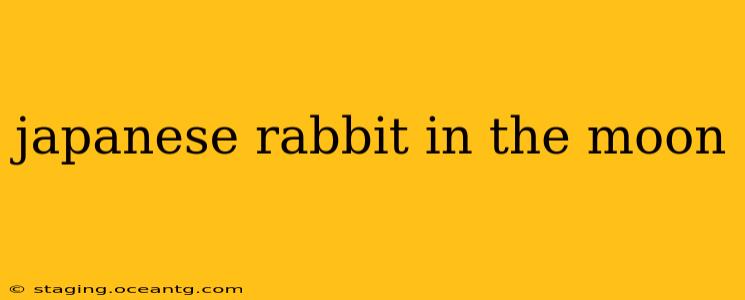The image of a rabbit pounding rice cakes in the moon is a deeply ingrained symbol in Japanese culture, appearing in art, literature, and folklore for centuries. Unlike the Western tradition of seeing a man in the moon, the Japanese see a rabbit, a creature often associated with gentleness, grace, and even spiritual purity. But the story behind this iconic image goes far beyond a simple visual representation; it's a rich tapestry woven with mythology, symbolism, and cultural nuances. This article delves into the fascinating world of the Japanese moon rabbit, exploring its origins, interpretations, and lasting impact on Japanese society.
What is the story behind the Japanese moon rabbit?
The most common version of the legend tells of a rabbit who encountered a poor old man disguised as a beggar. Many versions exist, but the core theme remains consistent: the rabbit, wanting to help the needy, offered the old man its own body to be cooked and eaten. The old man, revealed to be a god or deity in disguise (often Jizo or the Buddha), was deeply moved by the rabbit's selfless act. As a reward for its compassion and generosity, the god placed the rabbit's image on the moon, immortalizing its kindness for all eternity. This act emphasizes the importance of compassion and selfless service in Japanese culture.
Why is the rabbit pounding mochi in the moon?
The rabbit in the moon isn't just passively present; it's depicted actively pounding mochi, a traditional Japanese rice cake. The pounding action, while seemingly simple, carries symbolic weight. The rhythmic pounding represents the tireless effort and dedication required to create something meaningful. Furthermore, mochi itself symbolizes good luck, prosperity, and the cyclical nature of life and seasons, connecting the moon rabbit to themes of abundance and renewal. The constant pounding also serves as a visual representation of the continuous cycle of the moon itself.
What does the Japanese moon rabbit symbolize?
The Japanese moon rabbit symbolizes many things, including:
- Compassion and Selflessness: The foundational myth highlights these virtues as the defining characteristics of the rabbit.
- Purity and Grace: Rabbits are often seen as gentle and elegant creatures in Japanese culture, furthering the moon rabbit's positive symbolism.
- Dedication and Perseverance: The continuous pounding of mochi reflects tireless effort and commitment.
- Abundance and Prosperity: The mochi itself symbolizes good fortune and the blessings of a bountiful harvest.
- The Cyclical Nature of Life: The moon's phases mirror the cyclical nature of life, death, and rebirth, which the rabbit’s continuous actions on the moon embody.
Are there any other variations of the moon rabbit legend in Japanese culture?
While the central narrative remains consistent, regional variations and interpretations of the moon rabbit legend exist. Some versions involve different deities or emphasize specific aspects of the rabbit's character. The details might shift, but the underlying theme of selfless compassion and the reward for good deeds consistently persists, reinforcing core Japanese values.
How is the moon rabbit depicted in Japanese art and literature?
The moon rabbit's image is prevalent in various forms of Japanese art and literature. It frequently appears in ukiyo-e woodblock prints, calligraphy, and poetry, often depicted alongside other lunar motifs. The depiction often highlights the rabbit's gentle features and the rhythmic motion of pounding mochi, visually capturing the essence of the legend. The moon rabbit is also a common motif in contemporary Japanese art and design.
What is the difference between the Japanese moon rabbit and other cultures' representations of the moon?
Unlike the Western perception of a man in the moon, the Japanese moon rabbit stands out as a unique cultural interpretation. Other cultures also have their own myths and stories connected to the moon, reflecting diverse beliefs and traditions. While some share a similar theme of celestial figures or animals residing in the moon, the Japanese moon rabbit's emphasis on compassion and selfless service provides a distinctive and meaningful cultural message.
The Japanese moon rabbit is more than just a mythological creature; it's a powerful symbol that encapsulates significant aspects of Japanese culture and philosophy. Its enduring presence in art, literature, and folklore speaks to its lasting influence and its ability to resonate with people across generations. The enduring appeal of this image lies not only in its visual charm but also in the profound message it conveys about the value of compassion, perseverance, and the beauty of selfless acts.
